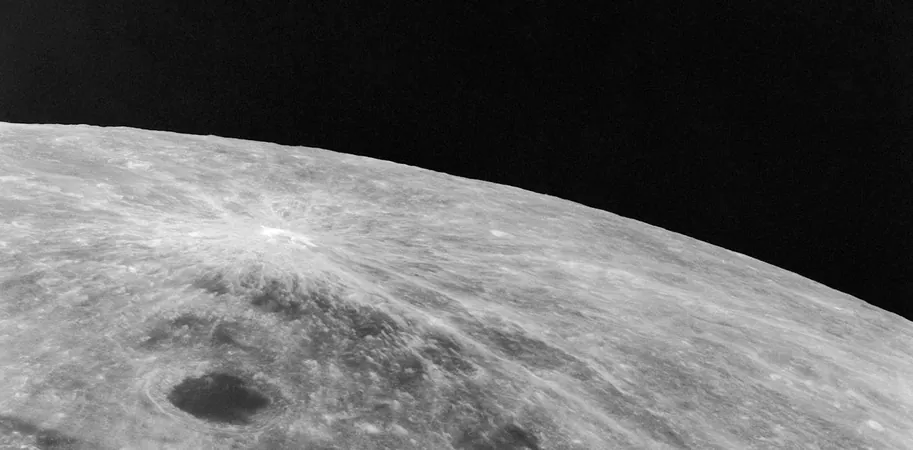
The Moon Awaits: 2025’s Triumphs and Challenges in Lunar Exploration
2025-05-16
Author: Nur
More than fifty years after the Apollo astronauts left their final footprints on the lunar surface, the Moon has once again emerged as a focal point of audacious ambitions and intricate engineering feats.
This time, it's not just national giants competing for supremacy; private companies, international partnerships, and robotic explorers are all vying to unveil the Moon’s mysteries and set the stage for human return.
The year 2025 has heralded a surge in lunar missions, with several key projects launching toward or landing on the Moon. Each mission must traverse the vastness of space, tackling the even more daunting descent to the lunar surface, with varying degrees of success. Together, they portray the dichotomy of hope and hardship that marks this modern space race defined by innovation and collaboration.
As an aerospace engineer specializing in guidance, navigation, and control, I’m fascinated by how each mission—regardless of its outcome—contributes to our collective knowledge. These endeavors are crucial for engineers seeking to master the domain of space and thrive in the Moon’s harsh conditions, paving the way for a sustained human presence.
Why Landing on the Moon is a Herculean Task
Lunar exploration remains one of the most technically challenging arenas in today’s space endeavors. Selecting a landing site involves a complex balancing act of scientific value, terrain safety, and optimal sunlight exposure.
The lunar south pole stands out as a prime target due to its potential water ice deposits hidden within shadowed craters—an essential resource for upcoming missions. Other areas may provide insights into the Moon's volcanic activity or the genesis of our solar system.
Engineers must meticulously calculate the mission's trajectory to ensure that the spacecraft arrives at the correct location and time. They face the challenges posed by the Moon's shifting orbit, timely launch windows, and gravitational forces throughout the journey.
The spacecraft’s descent angle and speed also require precise planning, as even minor miscalculations can lead to disastrous landing errors.
On the surface, landers must endure extreme temperature fluctuations—ranging from searing highs of 250°F (121°C) to bone-chilling lows of -208°F (-133°C)—as well as dust interference, radiation, and delayed communication with Earth. Their systems, instruments, and power must function flawlessly amid hazardous terrain relying solely on sunlight for recharging.
These formidable challenges elucidate why numerous landers have either crashed or suffered setbacks, even as technological advances have been made since the Apollo missions.
Commercial Ventures and Valuable Lessons
In 2025, numerous lunar missions are part of NASA's Commercial Lunar Payload Services (CLPS) program, aimed at leveraging private sector expertise to deliver scientific payloads to the Moon and drive costs down.
Firefly Aerospace’s Blue Ghost Mission 1 marked the first lunar mission this year, successfully landing in March. The craft withstood the harsh lunar day, transmitting data for nearly two weeks before succumbing to the frigid darkness.
This mission demonstrated the pivotal role that commercial landers can play in NASA’s Artemis program, set to return astronauts to the Moon soon.
However, not every mission ended in success. Intuitive Machines’ IM-2 mission, which aimed for the lunar south pole, saw its Nova-C lander, named Athena, tip over during landing due to uneven terrain, cutting its scientific ambitions short.
Nevertheless, the data collected will aid future landers in navigating similar challenges.
A Bright Future Ahead
Not all exploration requires landing; NASA's Lunar Trailblazer orbiter, launched alongside IM-2, aimed to map lunar water but lost contact shortly after launch, potentially due to power issues.
Meanwhile, Japan's ispace’s Hakuto-R Mission 2 successfully reached lunar orbit, following a bet on a longer trajectory. If successful, it could revive Japan’s commercial space ambitions after a previous crash.
2025 is set for a packed schedule as Intuitive Machines prepares for IM-3, testing advanced tools and delivering NASA experiments. The European Space Agency is also launching the Lunar Pathfinder to establish a dedicated communications satellite, enhancing connectivity for lunar missions.
Also on the horizon is Astrobotic’s Griffin Mission-1, scheduled to deliver NASA's VIPER rover to explore for ice at the Moon’s south pole.
Together, these missions underscore a new wave of international collaboration in lunar exploration. As humanity's gaze shifts back to the Moon, each endeavor—be it a victory or a setback—brings us closer to reconvening with our celestial neighbor.



 Brasil (PT)
Brasil (PT)
 Canada (EN)
Canada (EN)
 Chile (ES)
Chile (ES)
 Česko (CS)
Česko (CS)
 대한민국 (KO)
대한민국 (KO)
 España (ES)
España (ES)
 France (FR)
France (FR)
 Hong Kong (EN)
Hong Kong (EN)
 Italia (IT)
Italia (IT)
 日本 (JA)
日本 (JA)
 Magyarország (HU)
Magyarország (HU)
 Norge (NO)
Norge (NO)
 Polska (PL)
Polska (PL)
 Schweiz (DE)
Schweiz (DE)
 Singapore (EN)
Singapore (EN)
 Sverige (SV)
Sverige (SV)
 Suomi (FI)
Suomi (FI)
 Türkiye (TR)
Türkiye (TR)
 الإمارات العربية المتحدة (AR)
الإمارات العربية المتحدة (AR)